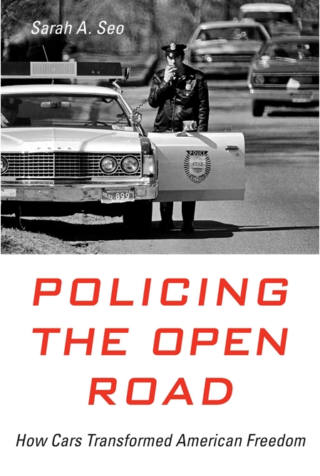
The idea that cars = freedom is a pervasive American myth. The truth is that the rise of the automobile — and rampant illegal behaviors that have always accompanied it — helped give rise to an armed street security force that too often acts as judge, jury, and executioner.
Sarah Seo’s book, Policing the Open Road (2019, Harvard University Press), is a cultural history of how we arrived at the system we have today, told through the lens of jurisprudence and law enforcement. It’s about how governments scrambled to regulate the automobile revolution, about the overwhelming volume of laws they created, the need to make them uniform, and how the process of creating the rules of the road, and enforcing them, transformed America’s concept of privacy and freedom.
Take, for example, driving on the right side of the road. After being ticketed by a state trooper for driving on the wrong side, a man hired a lawyer who argued that there was no “wrong” side, that the law merely stated that you had to pull to the right when you met an oncoming car. That man had his day in court and won. It seems that proto-advisory shoulders were the law of the land in early 20th-century Iowa.
Advertisement
The hiring of a lawyer tips-off one of Seo’s main themes: Before the automobile, the white upper classes did not interact with law enforcement. That changed with the advent of traffic laws. “Law-abiding citizens were apparently incapable of governing themselves on the road,” and they didn’t like being policed. They hired lawyers, complained, pushed-back and boasted of traffic violations at cocktail parties. “Maintaining the public’s support while at the same time managing traffic constituted ‘one of the police department’s most serious problems.’”
“Black citizens had to anticipate the possibility of encountering an abusive officer.”
Having to enforce laws upon the upper classes is what led to the professionalization of the police — the uniforms, the marked cars, the hiring standards. It led to criminalizing disobedience and the ticketing system. The growth of automobility served as “the justification and the modality for scaling up police law enforcement as a method for governing all American society.”
Prohibition and the need to search and seize, and later the War on Drugs, brought this juggernaut of policing into conflict with the Fourth Amendment’s constitutional protection against search and seizure. A large part of Seo’s book is about the path of case law trying to reconcile the novelty of a private object (the car) operating in the public space (the road), and ultimately the question of what is private and what is public. This legacy has left us with concepts such as reasonableness, probable cause, and a vast expansion of police officer discretion.
Advertisement
Seo doesn’t mention Black people until over half way through the book. That surprised me because her lede into the podcast interview I listened to prior to reading the book was the death of Sandra Bland, a 28-year-old Black woman who died while in police custody in Texas after being pulled over for a minor traffic violation. On the podcast, Seo noted that every step in Bland’s demise had involved a car and the police. Seo’s decision to leave out swaths of society in the first half of the book can be justified in that the transformation of jurisprudence she discusses was driven by middle-class white people in cars.
For me, that focus had the literary effect of giving the book the inevitability of a tragedy. It’s with dread one reads that “by directing officers to be considerate of the general motoring public but not of the criminally suspect, the mandate of courtesy implicitly acknowledged the police’s increasingly discretionary authority to discern the difference between the two.” We know which people will be considered criminally suspect — immigrants, the poor, Blacks. We know where this is headed.
This drumbeat builds to the second half of the book which seamlessly interweaves the racial and social issues of policing within the legal system. It’s in the final chapters that Seo discusses stop and frisk, the difference between arbitrary versus discriminatory policing, the targeting of civil rights activists for traffic stops, Driving While Black and the reality that “Black citizens had to anticipate the possibility of encountering an abusive officer.”
Last Friday, Seo wrote an op-ed for the New York Times advocating for automated speed cameras as a way of reducing police encounters and avoiding selective or discriminatory stops. She also mentioned better engineering of roads, noting that “the people who figured out how to draw a line down the middle of the road did more to enforce the the keep-to-the-right rule than anything the police could do.”
Policing the Open Road is the rare book which changes the way you look at the world. I found it unexpectedly moving and strongly recommend it, with the caveat that the second half will be tough going for readers who are not interested in the logic of case law and jurisprudence.
— Lisa Caballero, lisacaballero853@gmail.com
— Get our headlines delivered to your inbox.
— Support this independent community media outlet with a one-time contribution or monthly subscription.
"book" - Google News
April 20, 2021 at 11:29PM
https://ift.tt/3xbfDtq
Book Review: Policing the Open Road - BikePortland.org
"book" - Google News
https://ift.tt/2Yv0xQn
https://ift.tt/2zJxCxA
Bagikan Berita Ini















0 Response to "Book Review: Policing the Open Road - BikePortland.org"
Post a Comment